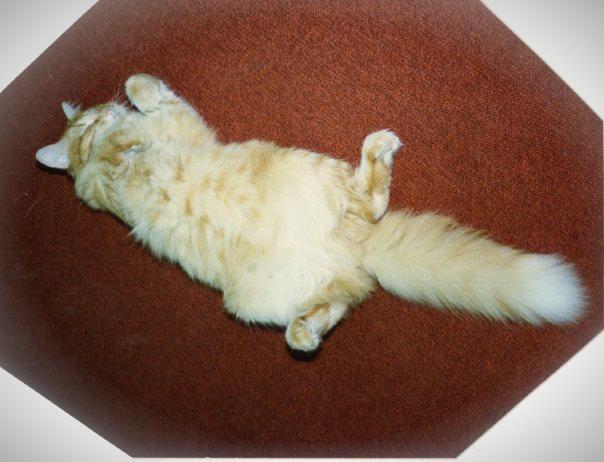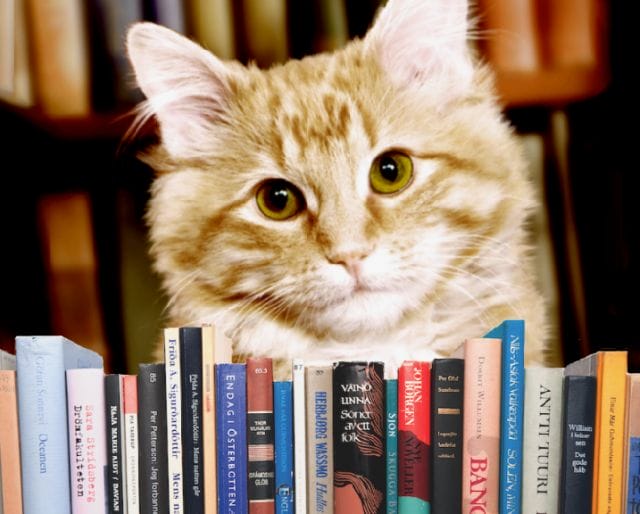
Generally speaking, cats are creatures of solitude. As far as pets go, they’re also pretty darn quiet — unless, heaven forbid, you’re a few minutes late in serving them a meal.
It makes sense then, that cats have long been a fixture at libraries. For centuries, bookkeepers have employed felines to keep pesky rodents at bay, greet visitors, and, of course, take epic naps in the Z section.
In the vast ranks of these so-called “library cats,” one became famous — both for his strange antics and his kind-heartedness. Over a nineteen year tenure as “head of PR” at a small library in Iowa, he charmed thousands of people from around the U.S., gave his town a renewed hope, and eventually became an international celebrity.
Meet Dewey Readmore Books, history’s greatest library cat.
The Strange History of Library Cats
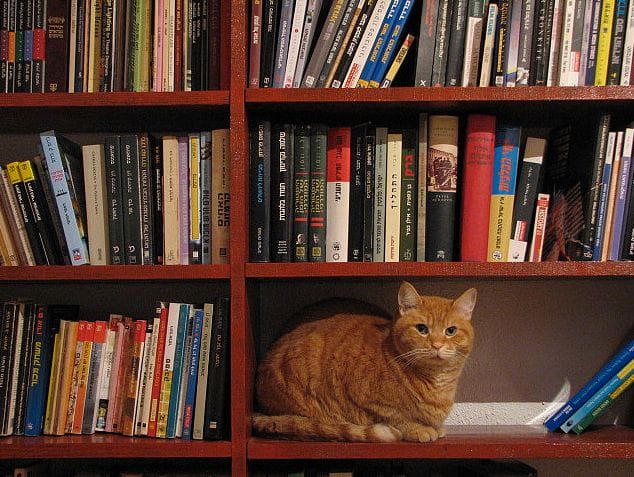
Some 1,500 years after cats were first domesticated, in 3rd century BC Egypt, the Library of Alexandria was constructed. With its ornate lecture halls, gardens, and collections of scrolls, it served as the nation’s epicenter of scholarship — and cats played a central role in its development.
Deep in the bowels of the building, a young, lowly sub-librarian by the name of Petsis toiled away. His job: to sort through and organize thousands of manuscripts, most of which were unlabeled and hard to identify due to the nibblings of rogue mice. Understandably, he often grew weary.
As recounted through the diligent research of The Molesworth Institute, Petsis would often divert his mind by fishing along the Nile. One day, a small cat approached him, sat by his side for several hours, and eventually followed him back to the library. The smitten Petsis named his new friend Myeo, and he became the world’s first “library cat.” Almost immediately, Myeo went about eradicating the pesky mice, and helping to preserve the manuscripts — and soon, Petsis had enlisted a small army of like-minded cats to join him.
In ancient Egypt, cats were a symbol of wisdom; surely enough, Petsis’ new felines encouraged a stroke of genius. As he recorded the “kills” of each cat on scraps of papyrus, he found himself left with a disorganized mess of names. His solution led to the first recorded instance of alphabetization:
“One evening, Petsis realized that if he put the scraps in alphabetical order by each cat’s name he would be able to find, and update, each record more rapidly. Shortly thereafter, he realized that he could apply the same principle to the organization of the scrolls. Thus, it appears, that Petsis, with a major assist from Myeo, was responsible for the introduction of alphabetization for ‘organization, classification, and cataloguing.”
Millenniums later, felines continued to carry on Myeo’s legacy.
Under the directive of Empress Elizabeth, cats were employed to roam the halls of Russia’s Hermitage Museum library. “Find the best and biggest cats, capable of catching mice,” she ordered in 1745, “and send them by cart with sufficient food immediately.” In 19th century Britain, librarians were paid extra to employ cats as a natural form of rodent control; likewise, records of cats in American libraries date back at least 150 years.
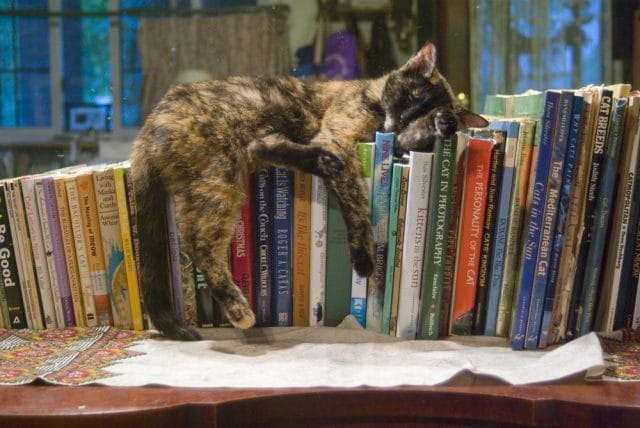
In 1987, Phyllis Lahti, a librarian in Minnesota, started the Library Cat Society. Her goals were twofold: to encourage the integration of cats at libraries, and to tout the advantages of a “feline literary presence” (mainly catching mice, and providing a homey environment for library-goers). For years, Lahti produced a little-known newsletter and attempted to compile a list of all known library cats in the United States before; eventually, at some point in the late 1990s, her efforts were disbanded — a filmmaker and stand-up comic named Gary Roma inadvertently stumbled across the society. He tells us how it went down:
“I was doing research in a library for another project, and in the Encyclopedia of Associations, I came across a listing for the Library Cat Society. So, I went through an archive of all the past newsletters, came up with list of library cats, and went on a road trip from Massachusetts to North Dakota to document all the library cats I could find.”
Roma’s initial list contained 75 cats, past and present. When he made a map of their locations and put it online, hundreds of librarians flooded his inbox with pictures and documentation of their library cats.
Today, Roma estimates there are 809 library cats worldwide — 664 of which are in the U.S. — as well as 507 past felines. And out of all of them, one cat was heads and tails above the rest.
“Dewey was the most beautiful cat I ever met — absolutely gorgeous,” he says.
“Dewey was a star.”
The Subtle Heroics of Dewey Readmore Books
Dewey just dew’n his thing
In the early hours of January 18, 1988, Vicki Myron, director of Iowa’s Spencer Public Library, walked out front to check the book drop. Over the years, she’d grown accustomed to finding odd things in the bin — garbage, rocks, and even firecrackers — but as she pulled the lid open on this frigid, -15F morning, she was completely taken aback.
Beneath a pile of books inside the metal box, a tiny kitten shivered and clung to life.
“He was so thin I could see every rib, so weak he could barely hold up his head,” she recalls. “And [he was] so cold – I couldn’t believe a living animal could be so cold. As he looked into my eyes, I knew he trusted me completely.”
After a brief meeting with the library’s board of trustees and Spencer’s city council, Myron was allowed to keep the kitten. After ten days of healing, paw rubbing, and copious self-cleaning, the kitten reanimated himself in his new home: the public library. He was soon donned “Dewey Readmore Books” — an homage to the Dewey Decimal System, a book indexing system instituted by most libraries.
At the time, spirits were not high in the sleepy Midwestern town of 11,000. Throughout the 80s, the family-run farming community had slowly been consolidated into factory operations. Unemployment rates had rocketed to ten percent, and long-time residents found themselves struggling to pay their mortgages. Dewey became welcome distraction.
Dewey quickly took to the library’s visitors: he greeted them at the door like a tiny statue, poked his head in between the holes on shelves, and embarked on a neverending quest to curl up in every lap he could lay his paws on. He only detested two people: local veterinarian James Esterly, and whoever was slated to give him a bath that week.
Unlike other library cats, he was wasn’t a fan of pursuing mice. If fact, he was downright terrified of them. “If a mouse ever came in here,” Myron told the LA Times, “Dewey wouldn’t know what to do with it.”
But Dewey’s true purpose came in the form affection — often toward those who needed it most.
When solemn, hardened men came in to peruse the jobs section, he’d nuzzle up against them; when he spotted lonely elderly folks, he’d trot over and but his head against their legs. Though dozens of children vied for his attention daily — sometimes violently — he took special care to not play favorites: each day, during storytelling hour, he’d pick a different kid to fall asleep on.
One 11-year-old, Crystal, was disabled and lacked the ability to move her limbs or speak. Upon each visit, her face lit up at the sight of Dewey, who’d leap up onto her wheelchair’s tray and sit with her.
Dewey’s most caring relationship of all was with the library’s director, the woman who’d saved him. Myron had led a life of hardships. She’d struggled through a divorce, a hysterectomy, and a devastating encounter with breast cancer that resulted in a double-mastectomy. She’d raised her daughter as a single mother while balancing work and illness. As Myron’s daughter turned 16, she began to retreat; conversations and interactions were harder to come by. When Myron began taking Dewey back to her house for holidays, the two bonded over him.
Dewey digging into the archives for some paperwork (aka, napping)
After two years, Dewey had become something of a local celebrity.
Recorded yearly attendance at the library had nearly doubled, to 100,000 visitors. Whereas Dewey’s food had been funded by the library staff early on, donations from the public now poured in, and amply supported his guilty pleasures: while he ate mostly regular cat food, he was known to feast, with immense joy, on the occasional cheeseburger or garlic chicken TV dinner.
When a local shop held a pet photo contest, Dewey crushed the competition, with 80% of the town’s votes. “Dewey wasn’t just the library’s cat,” recalls Myron, “he was [the town’s] cat.”
Soon, Dewey’s fame could no longer be contained by the small farming community.
When Gary Roma (the aforementioned filmmaker) embarked on his cross-country road trip to document library cats in the early 90s, he stopped by the shoot some footage of Dewey. In 1997, he released a short feature, Puss in Books: Adventures of the Library Cat, of which Dewey was “the star.” After the film went on to win Best Feature at multiple festivals around the U.S., “interview” requests from television shows, newspapers, and magazines poured in.
He was riding high — a cat in high demand — and he was loving every minute of it. But Dewey still made sure to keep up his library duties, which were listed on a placard in the his “study” at the back of the building:
1. Reducing stress for all humans who pay attention to him.
2. Sitting by the front door every morning at 9:00 am to greet the public as they enter the library.
3. Sampling all boxes that enter the library for security problems and comfort level.
4. Attending all meetings in the Round Room as official library ambassador.
5. Providing comic relief for staff and visitors whenever possible.
6. Climbing in book bags and briefcases while patrons are studying.
7. Generating free national and worldwide publicity for Spencer Public Library. (This entails sitting still for photographs, smiling for the camera, and generally being cute.)
8. Working toward status as world’s most finicky cat by refusing all but the most expensive, delectable foods — and even turning up his nose at those most of the time.
Fan mail was rife: letters came from the far corners of the Earth — Taiwan, Australia, Norway, South Africa. Every weekend, the library would be flooded with visitors from across the country, all eager to pat an obliging Dewey on the head. “We were simply Dewey’s answering service,” says Myron.
The library produced postcards featuring Dewey’s visage; soon, they were generating hundreds of dollars per month. Whereas Dewey once relied on donations, the hot-shot 10-year-old now supported himself.
But even after hitting the big-time, Dewey didn’t forget his roots. Spencer’s residents — the hardy locals who’d given him purpose, who’d inspired his love — remained his top priority.

Spencer Public Library, Iowa: Dewey’s home for 19 years
Dewey could only give so much.
As he entered the new millennium, at age 12, he began to noticeably weaken. Arthritis plagued his left hip, and visitors had to be extra careful about playing with him. In 2006, just after his 19th birthday, a routine visit to the vet revealed a large, inoperable stomach tumor. It was time for him to lay to rest.
On November 29, with the library staff by his side, he was peacefully put to sleep. The outpour was tremendous: 270 newspapers around the nation featured his obituary, and thousands of emails flooded the library’s inbox. His ashes were spread on the library grounds.
After his death, he continued to bring his loved ones fortune. Grand Central Publishing, in New York, approached Vicki Myron and offered her $1.2 million for the rights to Dewey’s story; the resulting book, Dewey the Library Cat, would go on to be a #2 New York Times Bestseller and sell over one million copies. Subsequently, there was even talk of a movie version, with Meryl Streep playing Myron — though this never seemed to formulate.
Today, a new cat — a tabby named Page — serves as Dewey’s successor. Though she’s equally loved by the town of Spencer, Dewey’s legacy has never been forgotten.
When You’re Feline Blue…
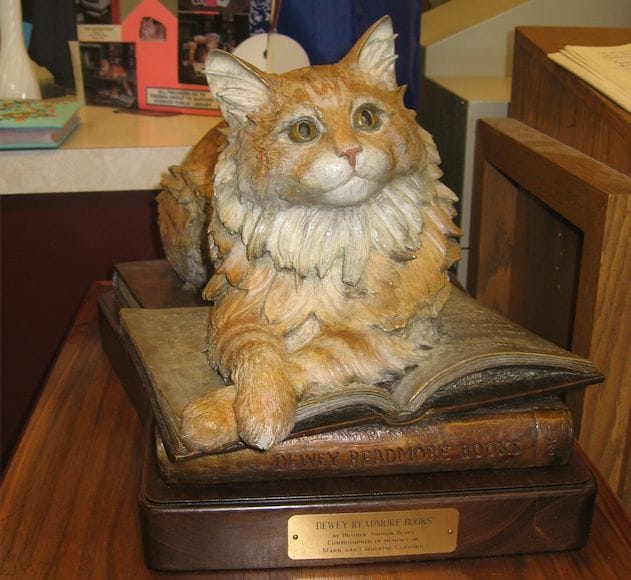
In general, library cats came with their fare share of controversy. “There were some patrons who thought having a cat in the library limited access to people who were either allergic to cats or afraid of cats,” says Gary Roma, “and there were some crazy stories.”
When one Connecticut woman complained about her local library cat and tried to get him removed, it became a massive controversy in the town; she received dead mice in her mailbox daily, and even received death threats. A library director in upstate New York who decided to remove his library cat due to allergy concerns was met with utter vitriol: two wealthy partons were so upset about it, they they disinherited the library. More than $80,000 was lost.
But Dewey seemed to transcend these issues. He was universally loved — not for any specific heroic deed, or supercat ability, but because he brought comfort to the downtrodden, the weary, the weak.
He changed lives, says Myron, “one lap at a time.”
Today, where Dewey once sat eagerly by the door, a bronze statue bearing his semblance greets visitors. Every once in a while, fans will still come by to give him a pat on the head. No one in Spencer has forgotten his impact.
“People went out of their way during vacations to come by this library in the middle of nowhere in Iowa to see this cat,” adds Roma. “That should tell you he was pretty special.”
![]()
Written by Zachary Crockett; you can follow him on Twitter here. To get occasional notifications when we write blog posts, please sign up for our email list.




